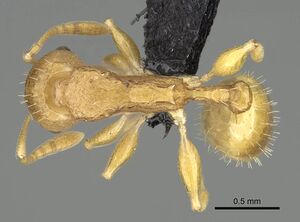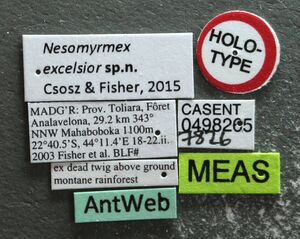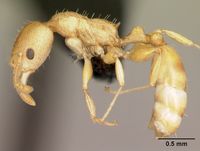Nesomyrmex excelsior
| Nesomyrmex excelsior | |
|---|---|

| |
| Scientific classification | |
| Kingdom: | Animalia |
| Phylum: | Arthropoda |
| Class: | Insecta |
| Order: | Hymenoptera |
| Family: | Formicidae |
| Subfamily: | Myrmicinae |
| Tribe: | Crematogastrini |
| Genus: | Nesomyrmex |
| Species group: | sikorae |
| Species: | N. excelsior |
| Binomial name | |
| Nesomyrmex excelsior Csösz & Fisher, 2016 | |
This species is known to occur in smaller, isolated montane rainforests between elevation of 520 m and 1325 m (mean: 1007 m) in the western and central part of Madagascar.
Identification
A member of the sikorai species-group.
Keys including this Species
Distribution
Latitudinal Distribution Pattern
Latitudinal Range: -13.26206° to -22.675°.
| North Temperate |
North Subtropical |
Tropical | South Subtropical |
South Temperate |
- Source: AntMaps
Distribution based on Regional Taxon Lists
Malagasy Region: Madagascar (type locality).
Distribution based on AntMaps
Distribution based on AntWeb specimens
Check data from AntWeb
Countries Occupied
| Number of countries occupied by this species based on AntWiki Regional Taxon Lists. In general, fewer countries occupied indicates a narrower range, while more countries indicates a more widespread species. |

|
Estimated Abundance
| Relative abundance based on number of AntMaps records per species (this species within the purple bar). Fewer records (to the left) indicates a less abundant/encountered species while more records (to the right) indicates more abundant/encountered species. |

|
Biology
Castes
Worker
Images from AntWeb
   
| |
| Worker. Specimen code casent0485106. Photographer Erin Prado, uploaded by California Academy of Sciences. | Owned by CAS, San Francisco, CA, USA. |
   
| |
| Holotype of Nesomyrmex excelsior. Worker. Specimen code casent0498265. Photographer Michele Esposito, uploaded by California Academy of Sciences. | Owned by CAS, San Francisco, CA, USA. |
   
| |
| Worker. Specimen code casent0499874. Photographer Erin Prado, uploaded by California Academy of Sciences. | Owned by CAS, San Francisco, CA, USA. |
Nomenclature
The following information is derived from Barry Bolton's Online Catalogue of the Ants of the World.
- excelsior. Nesomyrmex excelsior Csösz & Fisher, 2016b: 15, figs. 3, 9A-C (w.q.) MADAGASCAR.
Unless otherwise noted the text for the remainder of this section is reported from the publication that includes the original description.
Description
Worker
Body color: yellow; brown. Body color pattern: Body concolorous. Absolute cephalic size: 726 μm [671, 799]. Cephalic length vs. maximum width of head capsule (CL/CWb): 1.281 [1.218, 1.382]. Postocular distance vs. cephalic length (PoOc/CL): 0.457 [0.437, 0.477]. Postocular sides of cranium contour, anterior view orientation: converging posteriorly. Postocular sides of cranium contour, anterior view shape: convex. Vertex contour line in anterior view shape: straight; feebly convex. Vertex sculpture: main sculpture rugosoreticulate, ground sculpture smooth. Gena contour line in anterior view shape: convex. Genae contour from anterior view orientation: strongly converging. Gena sculpture: rugoso-reticulate with feeble areolate ground sculpture. Concentric carinae laterally surrounding antennal foramen count: present. Eye length vs. absolute cephalic size (EL/CS): 0.233 [0.221, 0.246]. Frontal carina distance vs. absolute cephalic size (FRS/CS): 0.289 [0.278, 0.304]. Longitudinal carinae on median region of frons count: present. Smooth median region on frons count: absent. Antennomere count: 12. Scape length vs. absolute cephalic size (SL/CS): 0.822 [0.786, 0.872]. Median clypeal notch count: present. Median carina of clypeus count: absent. Spine length vs. absolute cephalic size (SPST/CS): 0.275 [0.24, 0.315]. Minimum spine distance vs. absolute cephalic size (SPBA/CS): 0.225 [0.183, 0.272]. Apical spine distance vs. absolute cephalic size (SPTI/CS): 0.252 [0.198, 0.31]. Propodeal spine shape: straight; triangular, blunt. Apical distance of pronotal spines vs. absolute cephalic size (PSTI/CS): 0.607 [0.573, 0.633]. Metanotal depression count: present. Dorsal region of mesosoma sculpture: rugose with smooth ground sculpture. Lateral region of pronotum sculpture: inconspicuously areolate ground sculpture, main sculpture rugoso-reticulate. Mesopleuron sculpture: smooth round sculpture, superimposed by dispersed rugulae. Metapleuron sculpture: areolate ground sculpture, superimposed by dispersed rugae. Petiole width vs. absolute cephalic size (PEW/CS): 0.233 [0.206, 0.267]. Dorsal region of petiole sculpture: ground sculpture inconspicuously areolate, main sculpture rugoso-reticulate. Postpetiole width vs. absolute cephalic size (PPW/CS): 0.354 [0.321, 0.394]. Dorsal region of postpetiole sculpture: ground sculpture smooth, main sculpture dispersed rugose.
Type Material
Holotype worker: Madagascar: Prov. Toliara, Forêt Classée d'Analavelona, 29.2 km 343° NNW Mahaboboka, Madagascar, 1100 m, -22.675 N, 44.19 E, 18.ii.2003, collection code: BLF07826; CASENT0498265, Fisher et al., ex dead twig above ground montane rainforest (California Academy of Sciences, CASENT0498265);
Paratypes: 8 workers and a single gyne with the same label data with the holotype under CASENT codes: CASENT0763558, BLF07826, (2w, CAS); CASENT0498263, BLF07826, (3w, CAS); CASENT0498264, BLF07826, (3w, CAS); CASENT0498266, BLF07826, (1Q, CAS).
Etymology
The name (excelsior = higher, loftier) refers to the typically montane occurrence of this species.

